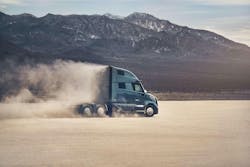How to spec the most fuel-efficient sleepers
It’s easy to see at the pump that diesel prices are always on the rise, but did you know a truck engines’ thirst for that fuel also goes up with age?
“A typical engine will start off at its maximum fuel economy, but then start losing 0.75-1% per year after about 450,000 miles,” noted Brian Antonellis, SVP of Fleet Operations at Fleet Advantage. “At the same time, [new models] typically become 2-2.5% more fuel efficient every year.
“It starts getting real close to where it becomes less expensive to replace a truck than trying to maintain it, especially with the higher costs we’re anticipating in coming years due to new EPA regulations,” he added.
These more stringent emissions requirements take effect for Model Year 2027 trucks, and many fleets are expected to pre-buy MY 2026 and older trucks to circumvent the costlier equipment designed to meet new regulations. Antonellis noted the projected price increase could be as much as $25,000 to $30,000 per vehicle, while others have estimated around $20,000. Even at that amount, fleets would see a 10% markup for a $200,000 Class 8 tractor.
Read more: EPA finalizes GHG Phase 3 emissions rules
The price hike is due to re-engineered dual SCRs, in a mandated effort to drop NOx by more than 80% and extend useful life. Fleets could also double their diesel exhaust fluid costs with the change. This is all speculative for now, but the potential new costs are enough to incite action at the fleet level.
“I think they’re afraid of the unknown,” theorized Antonellis, who was director of fleet operations at PepsiCo when the first aftertreatment systems were adopted around 2010.
He noted that the push for greener technology has led to “increased fuel economy, [which] has done wonders for the industry” and “driven profits to the bottom line.”
Those profits are at risk as fleets must soon purchase Phase II-compliant trucks, and in places like California, more costly zero-emission trucks.
What does any sensible person do when they know they’ll have big costs coming in the future? They save now.
Sure, that could mean pre-buying to get efficiency and simplicty benefits, but a surefire way to save is to implement those green solutions that Antonellis mentioned. Ranging from aero kits to auxiliary power units, these have bolstered bottom lines for years, and together they can have a dramatic impact on fuel cost.
Focusing on sleeper tractors in particular, which travel the most miles, we created a rundown of the components and accessories a fleet can spec to help even their thirstiest trucks sip, not guzzle, their fuel.
The trucks
There are actually several sleeper tractors available now that meet or exceed current fuel economy expectations. Here’s a look at some of the more notable.
Volvo Group
Volvo Trucks North America re-engineered the Volvo VNL, which includes five sleeper configurations, to improve fuel efficiency by 10% compared to the previous model. The better mpg comes from improved aerodynamics—a wedge-shaped cab, sloped windshield, and sleeker roofline—along with improvements to Volvo’s integrated powertrain, which includes the D13 engine and I-Shift automated manual transmission. Airflow was also directed to help cool the engine.
“The more you can keep the engine cool and utilize that wind, the less the fan turns on,” explained Bobby Compton, VTNA product marketing manager. “There’s still a lot of horsepower used when a fan comes on. And any time that horsepower is not being used to drive the tires, it’s not creating value for our customers.”
Read more: Walkthrough of the all-new Volvo VNL
At Volvo-owned Mack Trucks, the Anthem HE+ Package combines the fuel-efficient Mack MP8HE engine with a host of aerodynamic features to minimize drag and increase fuel efficiency by up to 9.5% compared to similar Mack Anthems without the HE engine and HE+ features.
Paccar
In 2021, Kenworth launched the next-generation T680, and the 76” high-roof sleeper is the company’s go-to OTR model. At the heart of the T680 is a fully integrated Paccar powertrain. But the big fuel-efficiency gains have resulted from a redesign that emphasized aerodynamics and improved airflow. Kenworth said the improved aerodynamic design can offer fleets up to 7% in fuel savings compared to a similarly spec’d T680 classic model.
“We focused on improving airflow by narrowing the hood and keeping air as tight to the cab and sleeper as possible,” said Brianna Potthast, Kenworth on-highway marketing manager. “This includes full fairings to the back of the sleeper with lower fairing extenders to help smooth airflow along the side of the truck. The A-pillar mounted turning vane was recently redesigned to further improve aerodynamics around the windshield and side of the cab.”
Other optional aerodynamic features on the Kenworth T680 include wheel well closeouts, tandem axle fairings, and wheel covers. “Depending on the customer’s use case, they can also opt for longer side extenders to close the trailer gap; 28” versus the standard 19”,” Potthast said.
Like Kenworth, Peterbilt’s flagship, the Model 579, also got a redesign in 2021. Touted as the most technologically advanced, fuel-efficient Peterbilt ever, this 579 improves upon the older version’s fuel efficiency by 7%. The Paccar powertrain, combining a Paccar MX engine and DX-40k tandem drive axles, offers an integrated solution for maximizing fuel efficiency and payload capacity. Advanced aerodynamics further drive fuel efficiency.
Navistar
International’s 2024 LT Series is the most aerodynamically efficient truck the company has ever offered. When paired with its most fuel-efficient powertrain, the S13 Integrated Powertrain, the company said fleets could see up to a 15% boost in fuel economy compared to a 2017 LT Series truck with aero package and 2017 GHG International A26 engine.
Daimler Truck
Freightliner’s Cascadia is powered by the Integrated Detroit Powertrain (IDP), which includes a DD13 or DD15 engine paired with a Detroit DT12 transmission and axles. Intelligent Powertrain Management (IPM) leverages predictive technology using GPS terrain maps to reduce fuel consumption. The Axle Lubrication Management 2.0 (ALM2) system regulates oil levels to reduce friction, extend gear life, and further improve fuel efficiency. Two aerodynamic packages are available.
The Aero Package includes an A-pillar deflector, tow hook covers, an upper door seal, 20-in. side extenders, side extender seals, drive wheel covers, full chassis fairings with enhanced flexible side skirts, and an aerodynamic hood and door/hood mirrors. The AeroX Package provides even greater fuel efficiency by bumping up to 24-in. side extenders and adding an optimized low ground clearance bumper, optimized drive wheel fairings, and aerodynamic height control.
In Part 2, we explore how spec'ing the right powertrains and engines impact fuel efficiency. In Part 3, we cover how tires, wheels, and engine oils do their part to cut fleet costs.
About the Author

Gregg Wartgow
Gregg Wartgow is a freelancer who Fleet Maintenance has relied upon for many years, writing about virtually any trucking topic. He lives in Brodhead, Wisconsin.



